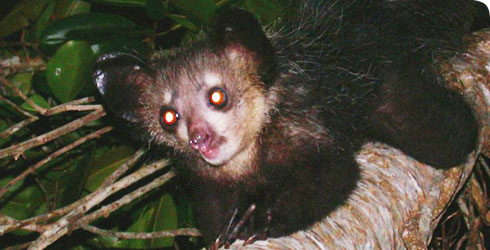Behaviour
Aye ayes have a diverse diet including:
- insects
- seeds
- fruit
- nectar
- fungus
The aye aye can locate wood-boring insect larvae by rapidly tapping its thin bony finger on a branch of a tree to locate a cavity and listen for the sounds of the grub burrowing under the bark.
On locating a grub, the aye aye will rip off the overlying bark with its incisors and insert its bony middle finger into the cavity to extract the grub.
Aye ayes also use their fingers to scoop out the pulp and juice from coconuts, and occasionally to extract the contents of an egg.
The aye aye is nocturnal. During the day the animals sleep in nests, which may be elaborately constructed and used for several days.
Males have large home ranges which overlap with those of at least one female and may overlap with those of other males. Females have smaller home ranges which they share with their young and do not overlap with those of other females.
Aye ayes have an extended breeding season or may even breed year-round.
Female aye ayes give birth to a single young every 2 to 3 years. Aye aye infants develop relatively slowly and have a long period of dependence compared to other lemurs. This prolonged period of dependency enables the infant to learn complex foraging techniques from its mother.
